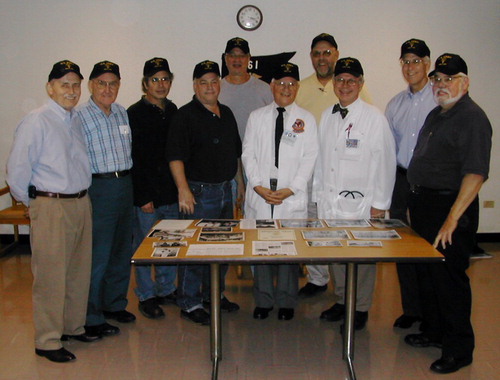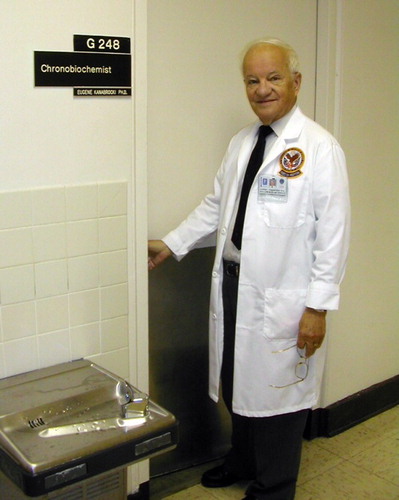It is with sadness that chronobiologists learned on April 23 of the unexpected passing of a dear colleague and friend, Col. Eugene L. Kanabrocki, Ph.D. Gene was an enthusiastic, kindhearted, and gifted person who loved life. He was devoted to his family, the Catholic and Polish communities of Chicago, his country of the United States of America, and research and discovery. In his profile in “The Achievements of Chronobiology and Chronomedicine” (Aslanyan & Madoyan, 2002) under “More Comments,” he wrote “I enjoy what I do.” Gene received his undergraduate degree in chemistry and physics from DePaul University (Chicago, 1948), MS degree in analytical chemistry from Loyola University (Chicago, 1969), and PhD in natural sciences from Jagiellonian University (Krakow, Poland, 1983; thesis title: Circadian variation in the urinary excretion of electrolytes and trace elements in man.).
Although he was small in stature, he was large in life. Gene was committed to and accomplished in his pursuits and interests, which were diverse. He had a long and distinguished military career. In 1942, as a young man, he joined the U.S. Army Reserve (USAR) Medical Service Corps, working at Walter Reed Army Hospital and over time rose to the rank of full Colonel. While in the military, he received numerous medals and honors, including the American Defense Service, American Campaign, European-African-Middle Eastern Campaign, World War II Victory, Army Reserve with three clusters, and Meritorious Service in 1976. When Gene retired from the USAR in 1977, he immediately affiliated with the Nuclear Medicine Service at the Edward Hines Jr. Veterans (VA) Hospital in Hines, Illinois—a position he retained until his passing. He was probably the first, if not the only, biological rhythm researcher to have been designated the title of chronobiochemist, which in fact was shown on his office nameplate (see ). Trained as a clinical chemist and research biochemist, Gene's career evolved from working in military hospital laboratories from 1942–1946; to working in clinical, metabolic, and radioisotope laboratories from 1946–1971; to becoming the Chief of the Hines VA clinical chemistry laboratory (serving five Chicago-area hospitals) from 1971–1973; and to being the chief chemist for the U.S. Treasury Dept Customs lab from 1973–1983.
Gene Kanabrocki will be forever remembered by chronobiologists and the field of chronobiology as a “circadian map-maker,” who, together with the late Larry E. Scheving (noted chronobiologist, treasurer, and president of the International Society of Chronobiology), was a pioneer in the concept of biological rhythm reference values (i.e., that a “normal value” has an underlying circadian time structure) and their documentation. In a longitudinal study that came to be unofficially known as the Medical Chronobiology Aging Project (MCAP), clinically healthy and/or symptom-free men consisting initially of members of the USAR 361st Medical Laboratory, and later additional military and scientific volunteers, were studied longitudinally on six occasions, at 5 to 10 yr intervals, over a 34 yr span (1969 to 2003). Gene organized and directed the around-the-clock studies during which a multitude of blood, urine, and physiological variables were sampled and analyzed for circadian rhythm characteristics. The first such study was conducted in San Antonio, Texas, in May 1969, with the findings reported in landmark publications by Kanabrocki and colleagues in Space Life Sciences (1973) and National Tech. Inf. Serv. (U.S. Dept. Comm. Doc. PB-228-487, 1974). Subsequent 24 h studies were conducted in a clinical research unit at the Hines VA Hospital in suburban Chicago, Illinois, in May 1979, 1988, 1993, 1998, and 2003 (see ). Gene had to overcome significant obstacles to succeed with the MCAP study. At that time, the field of medical/clinical chronobiology was unpopular; thus, it was difficult to research and finance. Gene was confident of and enthusiastic about the importance of his investigations. He tirelessly approached friends and strangers for any means of support. He refused to be defeated, and he succeeded in persuading various local and out-of-state laboratories to analyze the many biologic samples he collected for an ever-increasing number of variables, especially as new assays were developed, with only the promise of a potential co-authorship of a future research paper as enticement. Circadian rhythms were documented for up to 187 physiologic, urinary, and serum variables of men 23 to 81 years old who participated in one or more of his studies, in nearly 100 papers, abstracts, and book chapters and more than 70 poster sessions at local, national, and international meetings, with dozens of co-authors. This testifies to the importance as well as broad collaboration and productivity of these studies. Thanks in large part to the massive amount of data collected in these 24 h studies by Gene and Larry (plus similar studies of children and young and elderly adults of both sexes by Erhard Haus and colleagues), chronobiologists now have at hand a large reference database revealing circadian time-structures for use in clinical medicine and research. Gene had hoped to do a seventh study in 2008; however, because so many of the people that he depended on for material support had retired or relocated, it was not possible to accomplish the huge research undertaking on his own—even though many of the subjects expressed their willingness to participate, one (DL) specifically stating that he “still had a little blood and urine to spare in case the longevity study could go on.” Although Gene is well known for his chronobiology of aging research, he had other interests, which included atherosclerosis and its potential chronotherapy with inhaled heparin, diabetes, and most recently the chronobiology of multiple sclerosis.
FIGURE 2 Schematic illustrations of experimental design for each of the three experiments. The letters A, B, C, and D indicate the light treatment times for each of the experimental conditions. PT = psychomotor test session.

After complaining of stomach pain and fatigue, Gene was diagnosed with leukemia earlier this year, and in spite of aggressive treatment and nonstop care, he succumbed 2.5 months later. His biggest wish was to recover from this health crisis and return to his computer to complete the compilation and cataloguing of all the MCAP data collected over the 34 yrs for eventual use by others. Sadly, this was not to be. Gene Kanabrocki, preceded in death by his first wife, Rose, is survived by his beloved second wife, May Ryan-Kanabrocki; sister, Regina; two sons, Joseph (Marlies) and Paul (Sandra); five grandchildren (Alyce, Cazmir, Brianna, Dylan, Casimir); and many nieces, nephews, friends, colleagues, and co-workers. For those of us that had the pleasure to collaborate with Gene, we will never forget his gentle ways, kindness, and generosity; nor will we forget his consideration of others, eagerness to help, tireless efforts to publish, patience (!), ever-present smile and enthusiasm, his habit of never ending a phone call without a joke or two, and the advice: “don't take any wooden nickels!” Gene was a wonderful man and a dedicated chronobiologist who contributed much to the developing field of medical and clinical chronobiology and to all that had the pleasure of knowing him.
